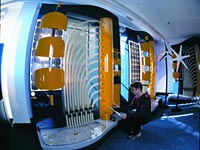|
|||||||||||||||||||||||||||||||||||||||||
| Photonic Engineering - 3644 | |||||||||||||||||||||||||||||||||||||||||

The School offers an up-to-date program targeting photonics engineering in line with the changing industry needs and market requirements. It offers students a complete coverage of photonics as an enabling technology for areas such as telecom, sensing, data storage and optical displays. The Degree programs are accredited by the Institution of Engineers Australia as meeting the requirements for admission to graduate membership.
The undergraduate curricula are being continuously and progressively revised to provide flexible training to suit the future needs of students. The program stresses the importance of design as an integral part of the engineer's capabilities and emphasises the multi-disciplinary requirements of this exciting profession. Note Photonic Engineering is also available as a component of the dual degree programs BE (Phtn Eng)/BSc program 3634,program 3634 BE (Phtn Eng)/BA, program 3703 program 3704 BE (Phtn Eng)/BCom, program 3715 ,program 3715 BE (Phtn Eng)/LLB, program 4778 program 4778 Program Objectives and Graduate Attributes Please see Rules
The program structure below gives one sequence of courses that fulfils the requirements of the degree. The timing of the general education courses and elective courses may be modified to optimize the student's choice of courses. Suggestions for other course sequences consistent with timetabling and availability can be found on the School website. While some courses are given twice a year, many courses are given only once a year. In addition, courses may have prerequisites and exclusions. Thus students should plan their enrolments appropriately.
Year 1
Choose ONE of:
And ONE of:
And ONE of:
And ONE of:
Plus these following courses:
Plus choose 2 electives from the Year 1 Elective list
Electives Suggested Year 1 electives for this program are:
Year 2
Choose ONE of:
Plus these following courses:
Note: ELEC1112 is an acceptable alternative for ELEC1111
Year 3
Plus Choose ONE of:
Year 4
Year 3 Electives
Year 4 Electives
Microelectronics Energy Systems
Signal Processing
Systems and Control
Data and Mobile Communications
Photonics
Business Administration
Please see Rules
Please see Rules
For information regarding fees for UNSW programs, please refer to the following website: https://my.unsw.edu.au/student/fees/FeesMainPage.html
All students are required to undertake mandatory industrial training. Each student is personally responsible for arranging and completing the full 60 days compulsory industrial training prescribed as part of the requirements for the award of the degree. Industrial training should be concurrent with enrolment and is best accumulated in the summer recesses at the end of the second and third years of the program, but it must be completed before graduating .Industrial training should be in the area of engineering design and/or project work, but limited credit may be given for work of a non-engineering nature. It is preferable that all 60 days be completed with one or two organisations. Students should, in general, work with professional engineers and take an active part in their work in the design of equipment, solving of engineering problems, or any other work that is relevant to the profession of Engineering.
Students are required to submit a written report on their industry placements, typically 2000-3000 words, describing the organisation of the Company, summarising the work done and the training received. The report must be accompanied by certification of their industrial placement by a senior company representative. Industrial Training will be assessed as a compulsory part of the course ELEC4122 Strategic Leadership and Ethics. Students must complete the industrial training requirement in order to receive a completed assessment for this course, but the industrial training assessment does not affect the mark received for ELEC4122. Rules Governing Substitutions, Pre-requisites and Student Exchanges
To suit the special abilities or needs of individual students, a limited number of course substitutions are permitted within each program. Any such substitution must have prior approval of the Head of School. Substitutions must be of at least the same length and level as the prescribed course. Core courses may not be substituted with other courses. Substitution is not normally permitted if it unduly restricts the range of courses studied to only one area of specialisation. Progression to ‘next level’ courses is not permitted without satisfying the nominated pre-requisites. In the case of a concurrent degree program, accreditation of any course in more than one program is not permitted. Prior School consent is required for any accredited substitution. This includes any courses taken from other schools at the student’s own initiative. Substitution is not normally permitted in the first two years of the program. Substitution of one postgraduate course within the School is permitted, provided a similar course is not offered at the undergraduate level. Student exchanges are permitted, and students are encouraged to organise their exchange in the second session of their third year in order to simplify the process of accrediting substitutions. Rules Governing Elective Courses 12 units of credit from the L3 and L4 electives provide the breadth and the depth required for an Electrical, Telecommunications and Photonic Engineering Degree. These electives are provided from the six disciplines within the School. In addition, L3 electives include courses from other Schools. Students must have completed at least 36 units of credit of Year 4 core and L4 elective courses in order to satisfy the requirements for graduation. Therefore students should choose their L3 and L4 electives accordingly. Note: Students are not permitted to count more than 60 units of credit (excluding the 12 units of credit of general education courses) of Year 1 courses towards the degree, as the required breadth and depth of the Electrical/Telecom/Photonics engineering program would not be obtained otherwise. Transfer from Other Programs/Advanced Standing Students/Mid-Year Entry The introduction of year 1 (L1), year 3 (L3) and year 4 (L4) electives accommodates students who are transferring from another program, are advanced standing or are in mid-year entry, as it allows them to complete required number of units of credit within the stipulated time of the normal program. Area(s) of Specialisation |
|||||||||||||||||||||||||||||||||||||||||


